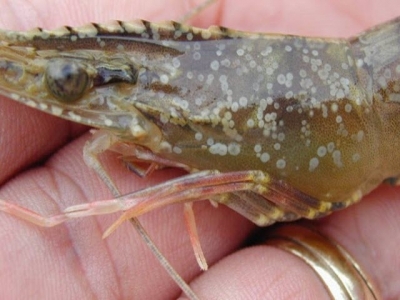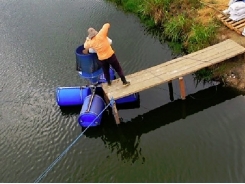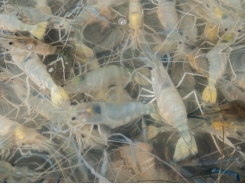White Spot Disease In Shrimp: How To Support Extensive Shrimp Farmers

Shrimp aquaculture is a billion-dollar industry worldwide. It provides about half a billion dollars in export earnings, livelihood, and employment of millions of people in Bangladesh. The mode of shrimp farm operations are mainly extensive in Bangladesh and many south Asian countries. White spot disease (WSD) caused by white spot syndrome virus (WSSV) has been a major threat to shrimp farming for last two decades.
Research and development showed the strategies to control WSD include biosecurity (e.g. exclusion of pathogen from broodstock in hatcheries and farms, zero water exchange, water treatment with disinfectants, probiotics, hygiene and sanitation of the workers, quality diet, and feed management), application of products with antiviral properties, immunostimulants, antimicrobial peptide, vaccinations, and optimum rearing condition.
Application of these strategies in extensive farmers is difficult due to lack of biosecurity, suboptimal rearing conditions, stocking of wild and or untested postlarvae, multiple batches of stocking and harvesting, and irregular feeding. The relationship of WSD outbreak and biosecurity and environmental factors such as temperature, salinity, and farming systems, are well known.

Figure 1: White spot disease-affected shrimp
Several studies in Asia and elsewhere have evaluated the performance of WSSV-negative postlarvae (PL) in intensive monoculture ponds (Withyachumarnkul, 1999; Peng et al., 2001) and provided evidence of the benefits in minimizing WSD-related losses.
The present study included 312 farmers who stocked polymerase chain reaction – tested WSSV infection free (WSSVF) and 324 farmers who stocked non-tested (NT) PL to assess the benefits of stocking WSSVF PL in extensive shrimp farms in southwest Bangladesh.
The present study showed that the mean farm area (0.46 ± 0.29 ha), shrimp stocking density, and stocking frequency of WSSVF PL users was significantly less compared to NT PL users (Table 1, Figure 2). Non-disease affected farms were smaller than disease-affected for both NT and WSSVF PL users. The mean water depth was significantly greater in WSSVF PL users farms.
Application rates of lime, inorganic fertilizer, and feed items were significantly higher in WSSVF PL users. Shrimp survival rate was significantly higher (27% vs 15%), disease occurrence was lower (29% vs 48%) and shrimp production was higher for WSSVF than NT PL users (289 kg vs 195 kg per ha). The gross profit and total returns of WSSVF PL users was significantly higher (Table 2). Notably, WSSVF PL users had gross profit from shrimp only while NT PL users depended on other species.

Table 1: Management characteristics, shrimp survival (%), shrimp production (kg/ha), disease incidence (%) of two shrimp PL user types

Figure 2: Relationship between stocking frequency and diseases occurrence of two shrimp PL user types

Table 2: Seed and input cost, return and profitability of two shrimp PL type users.
In extensive shrimp production systems, multiple stocking and polyculture appeared to be a key resilience strategy. Farmers affected with low shrimp production due to disease tend to reduce the risk by stocking more shrimp, prawn, and fish seed. WSSVF PL stocking had further strengthened the resilience strategy.
The study also highlights why several strict farm-level biosecurity measures, like single stocking and harvesting, monoculture, closed system, and only stocking WSSVF PL, cannot be applied in the context of extensive farms. Further research to understand the interactions of various management interventions, including WSSVF PL, multiple stocking, and polyculture, would help to revisit and refine some of the ongoing practice.
These findings are described in the article entitled Benefits of stocking white spot syndrome virus infection free shrimp (Penaeus monodon) post larvae in extensive farms of Bangladesh, recently published in the journal Aquaculture. This work was conducted by Muhammad Meezanur Rahman, Hendrik Jan Keus, Partho Debnath, M.B. Shahrier, Rayhan Hayat Sarwer, Quazi A.Z.M. Kudrat-E-Kabir, C.V. Mohan from WorldFish.
References:
Peng, S.E., Lo, C.F., Lin, S.C., Chen, L.L., Chang, Y.S., Liu, K.F., Su, M.S., Kou, G.H., 2001. Performance of WSSV infected and WSSV negative Peaneus monodon post larvae in culture ponds. Dis. Aquat. Org. 46, 165-172.
Withyachumnarnkul, B., 1999. Results from black tiger shrimp Penaeus monodon culture ponds stocked with post larvae PCR-positive or negative for white spot syndrome virus (WSSV). Dis. Aquat. Org. 39, 21-27.
Có thể bạn quan tâm
Phần mềm

Phối trộn thức ăn chăn nuôi

Pha dung dịch thủy canh

Định mức cho tôm ăn

Phối trộn phân bón NPK

Xác định tỷ lệ tôm sống

Chuyển đổi đơn vị phân bón

Xác định công suất sục khí

Chuyển đổi đơn vị tôm

Tính diện tích nhà kính

Tính thể tích ao hồ




 Culture water pre-inoculation of probiotics in Pacific white…
Culture water pre-inoculation of probiotics in Pacific white…  Cargill seeks to support Vietnamese aquaculture development
Cargill seeks to support Vietnamese aquaculture development